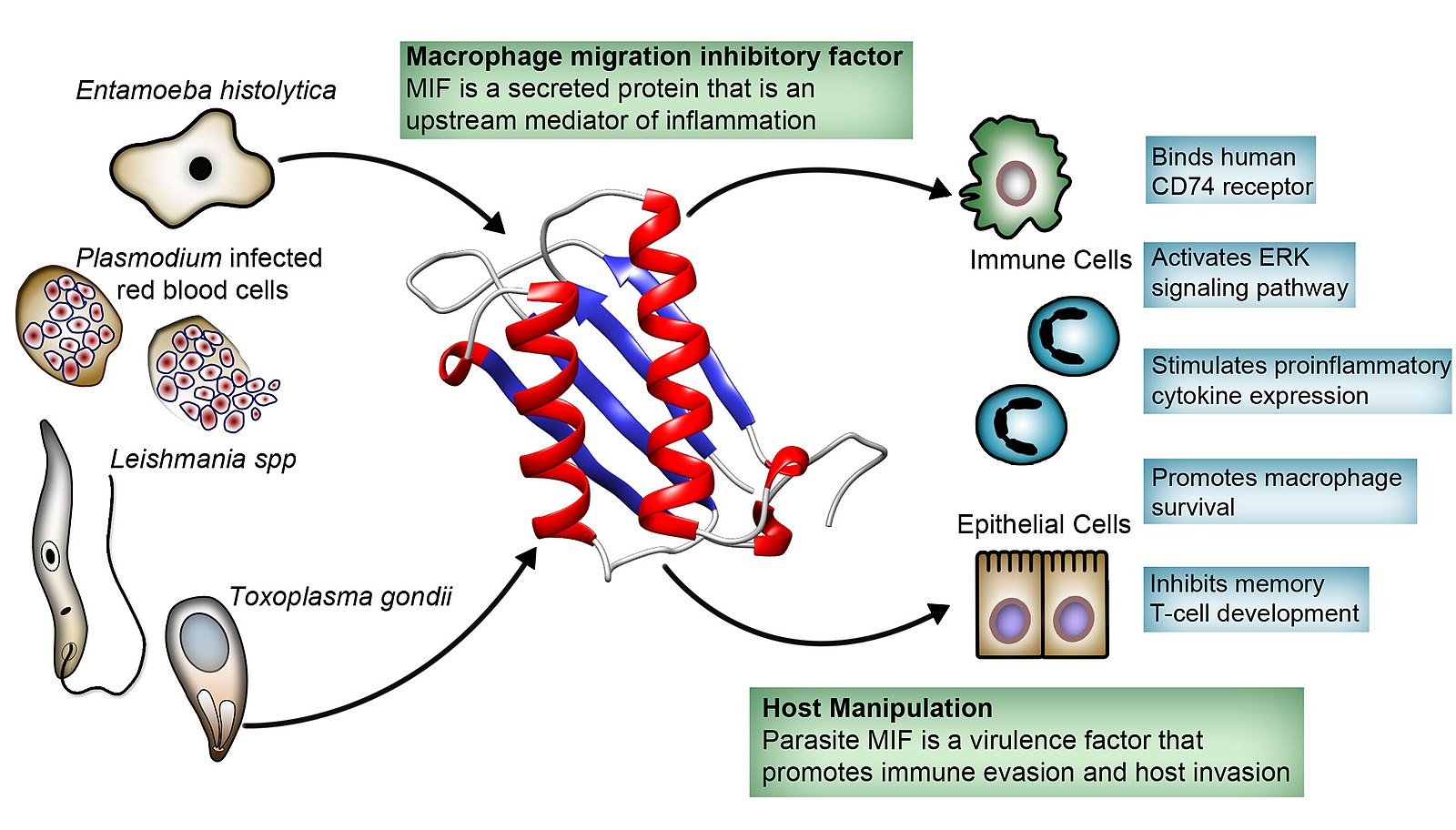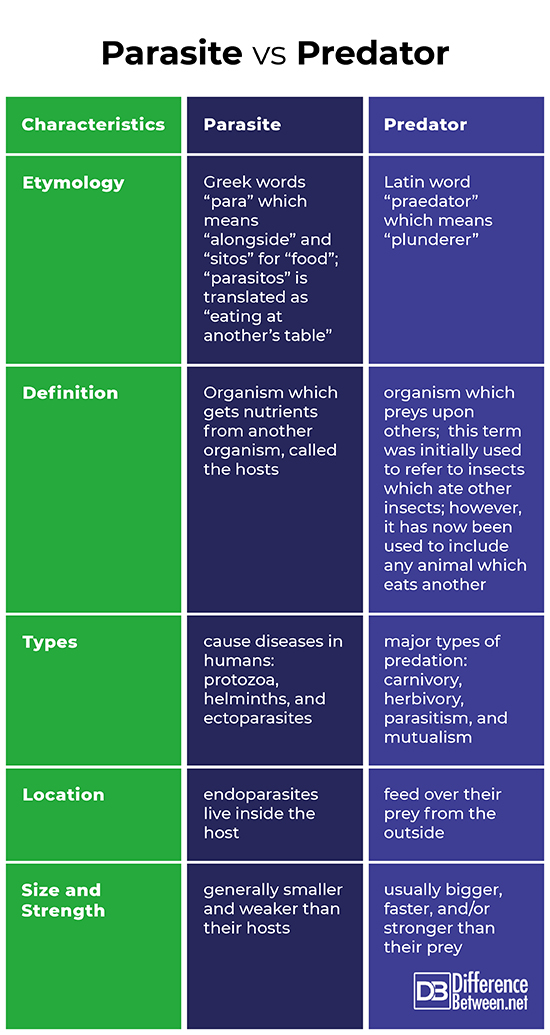Difference Between Parasite and Predator
Both parasites and predators are generally known to harm other organisms for survival. For instance, hook worms, one of the most common human parasites, attach to the wall of intestines and drink the blood of their hosts. Also, tigers, which are at the top of their food chain, hunt other animals like deer, wild pigs, and hares. However, parasites are typically smaller and weaker than their hosts while predators are usually bigger, faster, and/or stronger than their preys. The following discussions further delve into their distinctions.

What is a Parasite?
“Parasite” came from the Greek words “para” which means “alongside” and “sitos” for “food”; “parasitos” is translated as “eating at another’s table”. A parasite is another organism which gets nutrients from another organism, called the host. Parasites may or may not harm their hosts; however, the hosts never benefit from this relationship, called parasitism. Around 70% of parasites are not seen by the naked eye, these include some of the endoparasites which live inside the host. Endoparasites need a third organism, called a vector or carrier to be able to be transmitted to a host. On the other hand, those that live outside the body are called ectoparasites.
There are three main types of parasites which can cause diseases in humans: protozoa, helminths, and ectoparasites (Centers for Disease Control and Prevention, 2016).
- Protozoa are microscopic and unicellular organisms which can multiply in humans; those that live in the intestines are typically found in contaminated food or water. For instance, amebiasis, characterized by diarrhea and abdominal pain, is caused by the parasite, Entamoeba histolytica. Protozoa which live in human tissue or blood are transmitted by vectors. For example, sleeping sickness is caused by the protozoan parasites which belong to the genus Trypanosoma which are spread to humans by tsetse fly bites.
- Helminths are large and multicellular organisms which cannot multiply in humans in their adult form. They include flatworms (e.g. flukes and tapeworms), thorny-headed worms or spiny-headed worms (considered to rarely infect humans), and roundworms (e.g. Ascaris lumbricoides which cause ascariasis, an infection of the small intestines).
- Ectoparasites refer to organisms that burrow into the skin; for instance, ticks, lice, and fleas infest the skin and its appendages. They often function as transmitters of various pathogens.

What is a Predator?
“Predator” came from the Latin word “praedator” which means “plunderer”. A predator is an organism which preys upon others. This term was initially used to refer to insects which ate other insects; however, it has now been used to include any animal which eats another. This predator-prey relationship is also termed as predation.
There are four major types of predation: carnivory, herbivory, parasitism, and mutualism (McLaughlin, 2020).
- Carnivorous predators come in a variety of sizes; for instance, canines like lions typically hunt herbivores such as zebras and antelopes. They are generally hunters with strong bodies and sharp senses which can help them in hunting their preys. A number of apex predators or alpha predators (have no predators that hunt them) are carnivorous such as snow leopards and tigers. Regarding the plant kingdom, pitcher plants and Venus flytraps prey on insects. Also, cannibalism is one unusual form of carnivorous predation.
- Herbivorous predators consume autotrophs or organisms that can produce their own food such as plants. Just like carnivores, herbivores are adapted to their feeding mode; for example, cows have flat-topped teeth in their lower jaws while they only have hard pads of skin in their top jaws. These structures are useful in grinding grass which are eventually softened and swallowed.
- Parasitic predators are organisms which need hosts to survive. Since the host is the source of essential nutrients, it may become sick or lose access to nutrients. For example, tape worms can cause malnutrition in humans.
- Mutualism is characterized by an interaction of two organisms which provide nutrition and space for each other. An example of this mutually beneficial relationship is the interaction between humans and good bacteria in the gut which aid digestion and immunity.
Difference between Parasite and Predator
Etymology
“Parasite” came from the Greek words “para” which means “alongside” and “sitos” for “food”; “parasitos” is translated as “eating at another’s table”. In comparison, “predator” came from the Latin word “praedator” which means “plunderer”.
Definition
A parasite is an organism which gets nutrients from another organism, called the host. On the other hand, a predator is an organism which preys upon others. This term was initially used to refer to insects which ate other insects; however, it has now been used to include any animal which eats another.
Types
There are three main types of parasites which can cause diseases in humans: protozoa, helminths, and ectoparasites. As for predation, there are four major types: carnivory, herbivory, parasitism, and mutualism.
Location
A number of parasites, specifically endoparasites, live inside the host such as protozoa and helminths. On the contrary, predators do not live inside other organisms as they feed over their prey from the outside.
Size and Strength
Parasites are generally smaller and weaker than their hosts while predators are usually bigger, faster, and/or stronger than their prey.
Parasite vs Predator

Summary
- Parasites get nutrients from other organisms, called hosts while predators prey upon others.
- Unlike predators, endoparasites live inside the host.
- Parasites are generally smaller and weaker than predators.
- Difference Between Hematoma and Melanoma - February 9, 2023
- Difference Between Bruising and Necrosis - February 8, 2023
- Difference Between Brain Hematoma and Brain Hemorrhage - February 8, 2023
Search DifferenceBetween.net :
1 Comment
Leave a Response
References :
[0]Centers for Disease Control and Prevention. About Parasites. 2016. https://www.cdc.gov/parasites/about.html
[1]Centers for Disease Control and Prevention. About Parasites. 2016. https://www.cdc.gov/parasites/about.html
[2]Drisdelle, Rosemary. Parasites. London: University of California Press, 2010. Print.
[3]McLaughlin, Katy. Predation. Biology Dictionary. 2020. https://biologydictionary.net/predation/
[4]Image credit: https://storage.needpix.com/rsynced_images/tiger-2555813_1280.jpg
[5]Image credit: https://en.wikipedia.org/wiki/File:Parasite-Produced_MIF_Cytokine_in_Immune_Evasion,_Invasion,_and_Pathogenesis.jpg

Me and my dog are infected with parisites for three months now I’m disabled and can’t afford vet how do I get them out of us both?please ,I can’t lose my miha!